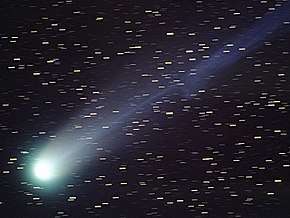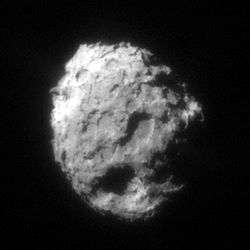45P/Honda–Mrkos–Pajdušáková
45P/Honda–Mrkos–Pajdušáková is a short-period comet discovered by Minoru Honda December 3, 1948.[7] It is named after Minoru Honda, Antonín Mrkos, and Ľudmila Pajdušáková. The object revolves around the Sun on an elliptical orbit with a period of 5.25 years.[1] The nucleus is 1.3 kilometers in diameter.[2] On August 19 and 20, 2011, it became the fifteenth comet detected by ground radar telescope.[8]
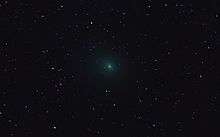 Comet Honda–Mrkos–Pajdušáková on February 10, 2017 | |
| Discovery | |
|---|---|
| Discovered by | Minoru Honda |
| Discovery date | December 3, 1948 |
| Orbital characteristics A | |
| Epoch | 2011-Jun-08 (JD 2455720.5) |
| Aphelion | 5.511 AU |
| Perihelion | 0.5296 AU |
| Semi-major axis | 3.0205 AU |
| Eccentricity | 0.8246 |
| Orbital period | 5.25 yr |
| Inclination | 4.257° |
| Earth MOID | 0.06 AU (9,000,000 km)[1] |
| Jupiter MOID | 0.106 AU (15,900,000 km)[1] |
| Dimensions | 1.3 km[2] |
| Last perihelion | December 31, 2016[3] September 28, 2011[1] June 29, 2006[4][5] March 29, 2001 December 25, 1995 |
| Next perihelion | 2022-Apr-26[6] |
During the 1995 perihelion passage, the comet was visible to Solar and Heliospheric Observatory (SOHO) on January 16, 1996, when the comet was around apparent magnitude 7 and 4.3° from the Sun.[7]
It is green because it emits diatomic carbon which glows green in the near vacuum of space.[9]
2011 passage
During the 2011 perihelion passage, the comet was recovered on 5 June at magnitude 21.[10] On 8 July, the comet had a magnitude of approximately 18,[11] and, as of 22 July, nuclear condensation was noticed around magnitude 16.[12] It was expected to reach a peak magnitude of around 7.3 in late September near perihelion.[13]
On August 15, 2011, the comet made a close approach of only 0.0600 AU (8,980,000 km; 5,580,000 mi) from the Earth[14][15][16] and it was studied by the Goldstone Deep Space Network.[17] Radar observations on August 19 and 20 detected echoes from the nucleus and coma.[8]
2017 passage
45P/Honda–Mrkos–Pajdušáková came to perihelion on December 31, 2016.[1] By February 4, 2017, it was around magnitude 7 and the coma was about 100,000 km across.[18] The comet required binoculars to be seen because of the low surface brightness.[19] The comet passed 0.08318 AU (12,444,000 km; 7,732,000 mi) from Earth on February 11, 2017, which was the same day as a lunar eclipse.[15][20]

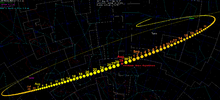
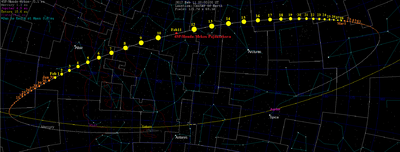 |
| This shows the path of the comet during January through March 2017, with daily motion drawn as spheres, scaled for relative distance from earth. |
The next notable close approach will be in October 2032[15] when the comet might brighten to magnitude 7.
References
- "JPL Small-Body Database Browser: 45P/Honda-Mrkos-Pajdusakova". Jet Propulsion Laboratory. Archived from the original on 2012-12-13. Retrieved 24 December 2015.
last obs. used: 2012-04-12
- "Arecibo Observatory captures revealing images of Comet 45P/Honda-Mrkos-Pajdusakova". Universities Space Research Association (USRA). Archived from the original on 2017-02-18. Retrieved 2017-02-17.
- Syuichi Nakano (September 10, 2011). "45P/Honda-Mrkos-Pajdusakova (NK 2118)". OAA Computing and Minor Planet Sections. Retrieved February 18, 2012.
- Seiichi Yoshida (2007-04-19). "45P/Honda-Mrkos-Pajdusakova". Seiichi Yoshida's Comet Catalog. Retrieved March 1, 2010.
- Syuichi Nakano (2006-06-30). "45P/Honda-Mrkos-Pajdusakova (NK 1357)". OAA Computing and Minor Planet Sections. Retrieved March 1, 2010.
- MPC
- "45P/Honda-Mrkos-Pajdusakova". Gary W. Kronk's Cometography. Retrieved 2007-03-25.
- "Goldstone Radar Detection of Comet HMP (Honda–Mrkos–Pajdušáková)". NASA/JPL Asteroid Radar Research. Retrieved September 28, 2011.
- "Green Comet Approaches Earth". Spaceweather.com. Archived from the original on 13 February 2017. Retrieved 14 February 2017.
- "MPEC 2011-L51 : OBSERVATIONS AND ORBITS OF COMETS". IAU Minor Planet Center. June 12, 2011. Retrieved June 13, 2011.
- "MPEC 2011-N34 : OBSERVATIONS AND ORBITS OF COMETS". IAU Minor Planet Center. July 8, 2011. Retrieved July 9, 2011.
- "MPEC 2011-O24 : OBSERVATIONS AND ORBITS OF COMETS". IAU Minor Planet Center. July 22, 2011. Retrieved July 23, 2011.
- "Elements and Ephemeris for 45P/Honda-Mrkos-Pajdusakova". minorplanetcenter.net. Comet Ephemeris Service at the IAU Minor Planet Center. Retrieved July 23, 2011. (0045P)
- JPL Epoch 2012-May-13 solution
- "JPL Close-Approach Data: 45P/Honda-Mrkos-Pajdusakova". Archived from the original on 2012-12-13. Retrieved 24 December 2015.
last obs. used: 2012-04-12
- "Comet Orbit Home Page". Kazuo Kinoshita. Retrieved 2007-03-25.
- Dr. Lance A. M. Benner (July 22, 2011). "45P Honda-Mrkos-Pajdusakova Goldstone Radar Observations Planning". NASA/JPL Asteroid Radar Research. Retrieved July 22, 2011.
- Comets and Asteroids
- Dr. Lance A. M. Benner. "Goldstone Radar Observations Planning: comet 45P/Honda-Mrkos-Pajdusakova, 2015 BN509, 2017 BW, 2013 WT67, 2017 BQ6, 2013 FK, and 2017 BY93". NASA/JPL Asteroid Radar Research. Retrieved 2017-02-09.
- St. Fleur, Nicholas (February 9, 2017). "Lunar Eclipse and Green Comet Make for Busy Friday Night in the Sky - Trilobites". The New York Times. Retrieved February 10, 2017.
External links
| Wikimedia Commons has media related to 45P/Honda–Mrkos–Pajdušáková. |
- Arecibo Observatory captures revealing images of Comet 45P/Honda-Mrkos-Pajdusakova
- Comet 45P/Honda-Mrkos-Pajdusakova Sky Charts and Coordinates
- Comet 45P/Honda–Mrkos–Pajdušáková: Visibility - NASA
- Orbital simulation from JPL (Java) / Horizons Ephemeris
- Elements and Ephemeris for 45P/Honda-Mrkos-Pajdusakova – Minor Planet Center
- 45P/Honda-Mrkos-Pajdusakova / 2011 – Seiichi Yoshida @ aerith.net
- 45P/Honda-Mrkos-Pajdušáková @ Royal Astronomical Society of New Zealand
- 45P/Honda-Mrkos-Pajdusakova 2001 passage at Astrosite Groningen (magnitude and coma estimates)
- 45P/H-M-P as seen by STEREO HI2A Comet Al (September 29, 2011)
- 45P as seen by STEREO-A HI-2
- 45P as seen on 2011-Jul-27 by Ernesto Guido, Giovanni Sostero & Nick Howes (GRAS 0.51m f/6.9 reflector)
- Michael Jäger color photo of 45P/Honda on 2011-09-29
- 45P as seen by SOHO on 1996/01/16 00:58 (visible halfway between the Sun and the top of the frame)
- 45P as seen by SOHO/SWAN on 2017-Feb-06 (visible upper left)
- Fritz Helmut Hemmerich, 2017-Jan-02 Astronomy Picture of the Day: Comet 45P Returns
| Numbered comets | ||
|---|---|---|
| Previous 44P/Reinmuth |
45P/Honda–Mrkos–Pajdušáková | Next 46P/Wirtanen |
